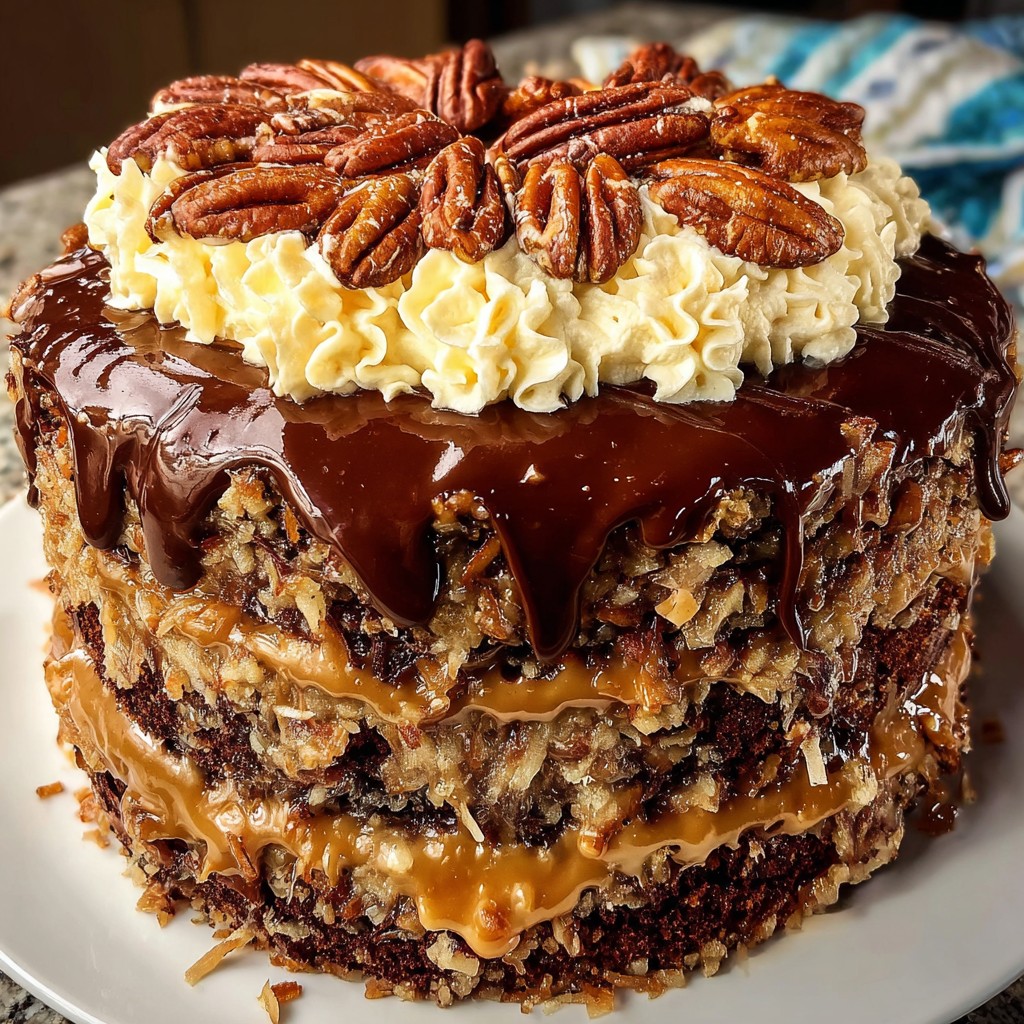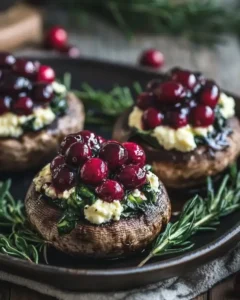Classic German Chocolate Cake: A Timeless Chocolate Delight
Imagine a cake with layers that simply melt in your mouth, blending the rich cocoa flavor with the sweet, nutty coconut pecan frosting. That’s the magic of the Classic German Chocolate Cake. This delicacy, contrasting the slight bitterness of chocolate with a lush, caramel-like filling, has won hearts and taste buds globally. Perfect for gatherings and celebrations, this dessert masterpiece is bound to impress with both its taste and presentation.
Upon your first bite, the moist chocolate layers reveal themselves, delivering a rich, deep cocoa note that isn’t overly sweet. Coupled with the decadent coconut frosting, this cake offers a harmony of flavors that is both indulgent and gratifying. Whether you’re an amateur baker or a seasoned pro, creating this recipe will reward you with a sense of nostalgia and pure chocolatey bliss.
Quick Recipe Highlights
- Flavor Profile: The cake balances sweet, creamy, and chocolatey flavors, leaving a lingering taste of rich cocoa and caramelized coconut.
- Texture: This cake features a tender crumb with a moist interior, complemented by the slightly crunchy coconut and pecan topping.
- Aroma: As it bakes, the air fills with the scent of warm chocolate and toasted pecans, a combination that’s both comforting and inviting.
- Visual Appeal: Each slice reveals the perfect combination of dense chocolate layers and a golden frosting with pecans, creating a show-stopping presentation.
- Skill Level Needed: An intermediate-level dessert, this cake requires layered assembly and frosting techniques but rewards the effort with stunning results.
- Special Equipment: To achieve the best layers, using an offset spatula and a cake turntable is recommended for even frosting.
Recipe Overview
- Difficulty Level: Though considered intermediate due to its layering and exact frosting techniques, following step-by-step instructions ensures a majestic outcome.
- Category: Desserts – ideal for grand finales to a dinner party or Sunday family gathering.
- Cuisine: A classic American favorite with German influences, emphasizing chocolate and coconut’s rich and exotic attributes.
- Cost: This recipe is moderately priced, mainly for holidays or special occasions due to the need for high-quality cocoa and fresh coconut.
- Season: Best enjoyed in cooler months, when the comforting chocolate and nutty flavors can be savored alongside warm drinks.
- Occasion: Perfect for birthdays, anniversaries, or holiday tables, where dessert is the star highlight of the meal.
Why You’ll Love This Recipe
The Classic German Chocolate Cake stands out with its distinctive taste and generous layers. Each forkful presents an enticing mix of lush cocoa and creamy coconut, backed by just the right amount of sweetness. Its enduring popularity can be attributed to its ability to meet diverse preferences within a single, elegantly crafted dessert. With its moist cake layers, this dessert remains fresh and delectable well into the next day, making it perfect for preparing ahead of time.
The preparation, while requiring dedication, is a rewarding process that brings joy even before the first bite. From watching the batter rise perfectly to mixing the warm coconut frosting, each step offers a pleasurable baking experience.
Nutritionally, this cake provides a reasonable indulgence with fiber from coconut and nuts, along with the mood-boosting benefits of dark chocolate. It aligns well with special diets when opting for low-sugar or whole-grain variants. Socially, it’s a crowd-pleaser, triggering nostalgic conversations while adding sophistication to any event.
Cost-wise, its ingredients are cost-effective considering the servings, making it financially sound for large gatherings without sacrificing quality. Moreover, using staple pantry items ensures this dessert fits comfortably into various budgets, with splurges reserved for premium chocolate for those extra-special occasions.
Historical Background and Cultural Significance
The origin story of the Classic German Chocolate Cake is as interesting as its taste. Contrary to popular belief, it’s named not after the country, but after Sam German, an American baker who created a type of dark baking chocolate for the Baker’s Chocolate Company in 1852. The cake gained tremendous popularity in the 1950s when the iconic recipe was widely circulated and eventually transformed it into a staple American dessert.
Culturally, the cake reflects an era of luxurious indulgence paired with comfort foods that appealed to the American palate. It symbolizes an amalgamation of creativity and tradition, offering a dessert experience that bridges generations. Its evolution from a mere chocolate-based recipe to an iconic layer treat speaks volumes about consumer trends and the timeless craving for chocolate.
Regional variations have emerged as bakers infuse local touches, from adding liqueurs to incorporating different nuts, capturing the essence of diverse locales. The adaptability only adds to its allure, allowing bakers to stamp their personal flair while still respecting the traditional roots of this confectionery delight.
Ingredient Deep Dive
Cocoa powder, the star element of this cake, boasts a rich history dating back to ancient Aztec and Mayan cultures, where it was considered a sacred substance. Known for its antioxidant properties, cocoa provides significant cardiovascular benefits. Select unsweetened, high-quality cocoa for a bold chocolate intensity, keeping it in a cool, dry place to maintain freshness. Substitute with dark chocolate for a denser texture or vary sweetness as needed.
Coconut, found within the filling, bestows unique tropical sweetness. Considered a symbol of prosperity in many cultures, it packs fiber and essential minerals like manganese. When choosing coconut, opt for fresh or high-quality desiccated products, storing in an airtight container. Finely shred for smoother frosting, or substitute with ground almonds for a nutty variation.
Common Mistakes to Avoid
- Not allowing the cake to cool completely before frosting, leading to melted frosting layers.
- Overmixing the batter, causing a dense, chewy cake instead of a light, fluffy texture.
- Skimping on quality chocolate, which affects overall taste and richness.
- Skipping the testing step for cake doneness, risking undercooked layers.
- Forgetting to toast the pecans, reducing flavor complexity and texture.
- Failing to pre-measure all ingredients, which can disturb the baking process and timings.
- Using old baking powder or soda affects the cake’s rise and texture.
- Applying frosting too soon, causing structural collapse and uneven layers.
- Neglecting to cut off the cake dome, which leads to uneven assembly.
- Overlooking the need for room temperature ingredients for smoother blends.
Essential Techniques
Mastering the perfect whip for your egg whites is essential for a light, airy cake. Properly beating egg whites involves ensuring no yolk contamination and whipping at the right speed to achieve stiff peaks. A common pitfall is over-beating, which creates a dry, crumbly mixture. Visual cues for success include glossy peaks that maintain their form when the whisk is lifted and do not drip.
Pro Tips for Perfect Classic German Chocolate Cake
For optimal consistency, gradually add your dry ingredients alternately with wet elements to the batter. Maintaining this alternating pattern prevents overmixing, ensuring the cake remains tender. Always toast the pecans before incorporating into the frosting to enhance their flavor profile.
Keeping your work surface clean while frosting allows for neater layers and a polished finish. Use a rotating cake stand to facilitate smooth and even frosting coverage, ensuring visual perfection. Allow the cake to rest in the fridge for about an hour before slicing for clean, precise cuts.
Variations and Adaptations
For a nut-free variation, consider replacing pecans with sesame seeds or diced dried fruits to maintain the texture without compromising taste. During summer, substitute shredded coconut with pineapple for a tropical twist.
For a healthier version, incorporate whole-wheat flour for half the all-purpose portion and use dark chocolate with higher cocoa content for a richer, less sugary bite. Vegan adaptations include egg substitutes and coconut cream for traditional dairy fillings.
Serving and Presentation Guide
Allow creativity to guide your plating technique by using thin chocolate curls to garnish each slice for dramatic flair. Garnish with fresh berries or a dusting of cocoa powder for contrasting color.
Traditionally, whipped cream pairs beautifully with each plate, cutting through the cake’s richness. Consistency in slice size ensures better portion control, ideally serving for a gathering of four to maintain balance and presentation.
Wine and Beverage Pairing
Pair your dessert with a rich, fruity port or sherry to complement the cake’s sweet, chocolatey notes. For non-alcoholic options, a thick, frothy milkshake or rich hot cocoa provides a warming counterpart.
Coffee lovers can match this cake with a robust espresso or chicory blend, enhancing the cocoa’s bitterness. Consider serving all beverages slightly chilled or warm to match the season and guest preferences.
Storage and Shelf Life
Store your cake in an airtight container at room temperature for up to two days or refrigerate to extend its shelf life to five days. Plastic wrap protects from drying out and retains moisture. Always observe any changes in color or dryness before serving.
Freezing is possible, although it’s best to frost after defrosting to preserve structural integrity. Allow it to thaw in the fridge overnight before applying fresh frosting or serving.
Make Ahead Strategies
Prepare the chocolate layers a day ahead, wrapping tightly in cling film to trap moisture. Assemble the cake the day of serving to ensure the filling’s freshness, storing it at room temperature for optimal enjoyment.
If making the frosting ahead, chill and rewhip to manage consistency before applying. Fresh berries or nuts should always be added last to maintain freshness and vibrant presentation.
Scaling Instructions
For a smaller gathering, halve the recipe using the same baking tin size for a shorter bake time. Doubling requires larger tins and accommodating oven space, extending cooking time slightly.
Adjust frosting based on personal preference, ensuring the spread remains proportional. Store any excess cake by wrapping single slices separately for easy, portioned enjoyment.
Nutritional Deep Dive
This Classic German Chocolate Cake serves as a delightful indulgence, offering energy-dense calories primarily from fats and sugars. Healthy adjustments, such as reduced sugar content and alternative flours, can balance nutritional intake.
Rich in antioxidants from the chocolate, it also provides essential minerals like iron and magnesium. Coconut benefits digestion due to its fiber content, making this cake a gratifying experience in moderation.
Dietary Adaptations
For a gluten-free adaptation, trade all-purpose flour for almond or gluten-free blends, adding a bonding agent like xanthan gum. Dairy-free options involve substituting milk with almond or coconut milk.
Vegan alterations require flaxseed meals for eggs, while a keto twist involves almond flour and sweeteners like erythritol, ensuring chocolate remains above 85% cocoa. These make this Classic German Chocolate Cake universally enjoyed, regardless of dietary need.
Troubleshooting Guide
Should your cake turn out crumbly, ensure fat ratios and baking times are double-checked. Dense cakes may need less mixing or fresher leavening agents.
Balance off flavors by adjusting salt or coffee for enhanced chocolate notes. If your layers topple, ensure cakes are leveled and construct over a stable, clean surface with secured frosting.
Recipe Success Stories
Community bakers acclaim this Classic German Chocolate Cake for its crowd-pleasing flavors and reliable results. Variations span from rum-laced adaptations to zesty orange-infused frostings, showcasing its versatility.
Readers share triumphant tales of creative designs and unexpected ingredient substitutions contributing to newfound family traditions. Tips for maximizing flavor rest time and intricate decoration ideas enrich its appeal.
Frequently Asked Questions
Yes, the cake layers can be made one day in advance. Wrap them tightly in plastic wrap and refrigerate until needed, to preserve moisture and flavor.
Ensure you correctly cream butter and sugar until light and fluffy, and do not overmix once adding flour. Also, check that your baking powder is fresh.
Allow the cake layers to cool completely before frosting and work in a cool environment to keep the frosting firm. Refrigerate the cloth layers before applying.
Substitute nuts with seeds or fruits if necessary, keeping texture contrasts intact without compromising flavor profiles.
Use a sharp, hot knife, wiping between cuts to maintain a clean edge. Serve slices laid flat, emphasizing layer aesthetics.
Uneven cakes may result from domed layers or imbalanced ingredient distribution. Level cakes before stacking to improve uniformity.
Gently brush with a simple syrup before frosting to add moisture and amplify flavors during assembly.
It’s preferred to freeze the cake layers unfrosted; however, if frosted, ensure it’s well-wrapped to prevent texture changes upon thawing.
Substitute coconut with finely shredded almonds or omit entirely if catering to specific dietary requests, maintaining the core cake structure.
Choose high-quality natural cocoa or dark chocolate that complements the cake’s intended richness and flavor depth.
Additional Resources
Explore more classic chocolate recipes like the decadent Black Forest cake or molten lava cakes for an array of cocoa-rich delights that complement the Classic German Chocolate Cake’s allure.
Delve into technique guides focusing on precision baking and frosting tips to master cake artistry. Investigate ingredient flowcharts ensuring quality sourcing and making informed, nutritional choices.
For equipment, consider ergonomic spatula sets and nonstick bakeware to optimize preparation efficiency and final presentation accuracy. Indulge in seasonal variations that reinvigorate traditional favorites or empower innovative flavor pairings.
Print
Classic German Chocolate Cake
Description
A rich and moist chocolate cake topped with a delicious coconut-pecan frosting.
Ingredients
For the Crust:
- 1 cup granulated sugar
- 1 cup brown sugar
- 2 cups all-purpose flour
- 1/2 cup unsweetened cocoa powder
- 1 teaspoon baking soda
- 1/2 teaspoon baking powder
- 1/2 teaspoon salt
- 2 large eggs
- 1/2 cup unsalted butter, melted
- 1 cup buttermilk
- 1 teaspoon vanilla extract
- 1 cup boiling water
- 1 cup shredded coconut
- 1 cup chopped pecans
Instructions
1. Prepare the Crust:
- Preheat the oven to 350°F (175°C) and grease two 9-inch round cake pans.
- In a large bowl, combine the granulated sugar, brown sugar, flour, cocoa powder, baking soda, baking powder, and salt.
- Add eggs, melted butter, buttermilk, and vanilla extract to the dry ingredients and beat until well combined.
- Gradually add the boiling water to the batter, mixing slowly until smooth.
- Divide the batter evenly between the prepared cake pans and bake for 30-35 minutes, or until a toothpick inserted into the center comes out clean.
- Allow cakes to cool in the pans for 10 minutes, then remove from pans and cool completely on a wire rack.
- For the frosting, in a medium saucepan over medium heat, stir together evaporated milk, sugar, egg yolks, and butter until thickened.
- Remove from heat and stir in vanilla, coconut, and pecans. Let cool until spreading consistency.
- Spread frosting between layers and over the top and sides of the cake.
Notes
You can customize the seasonings to taste.





